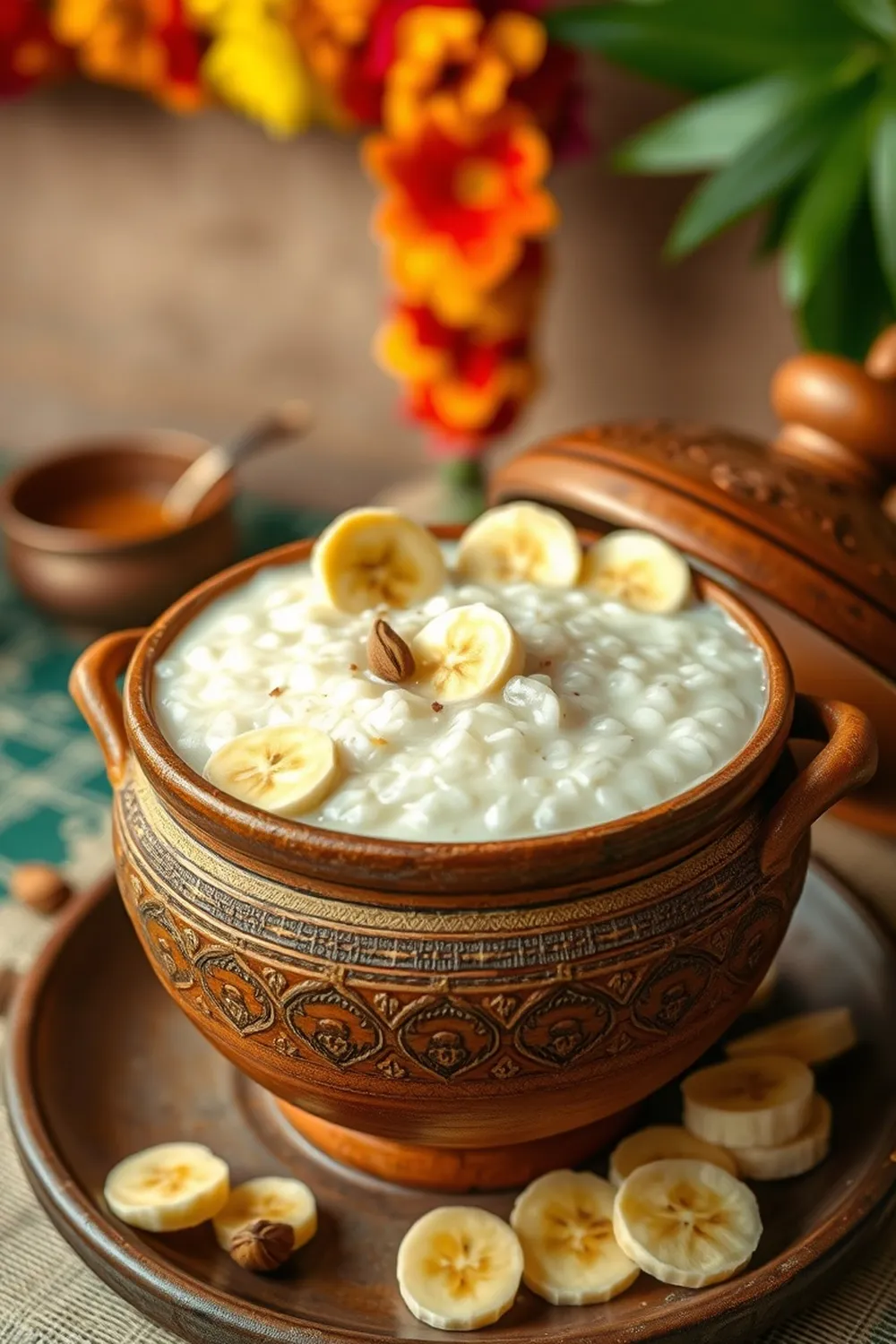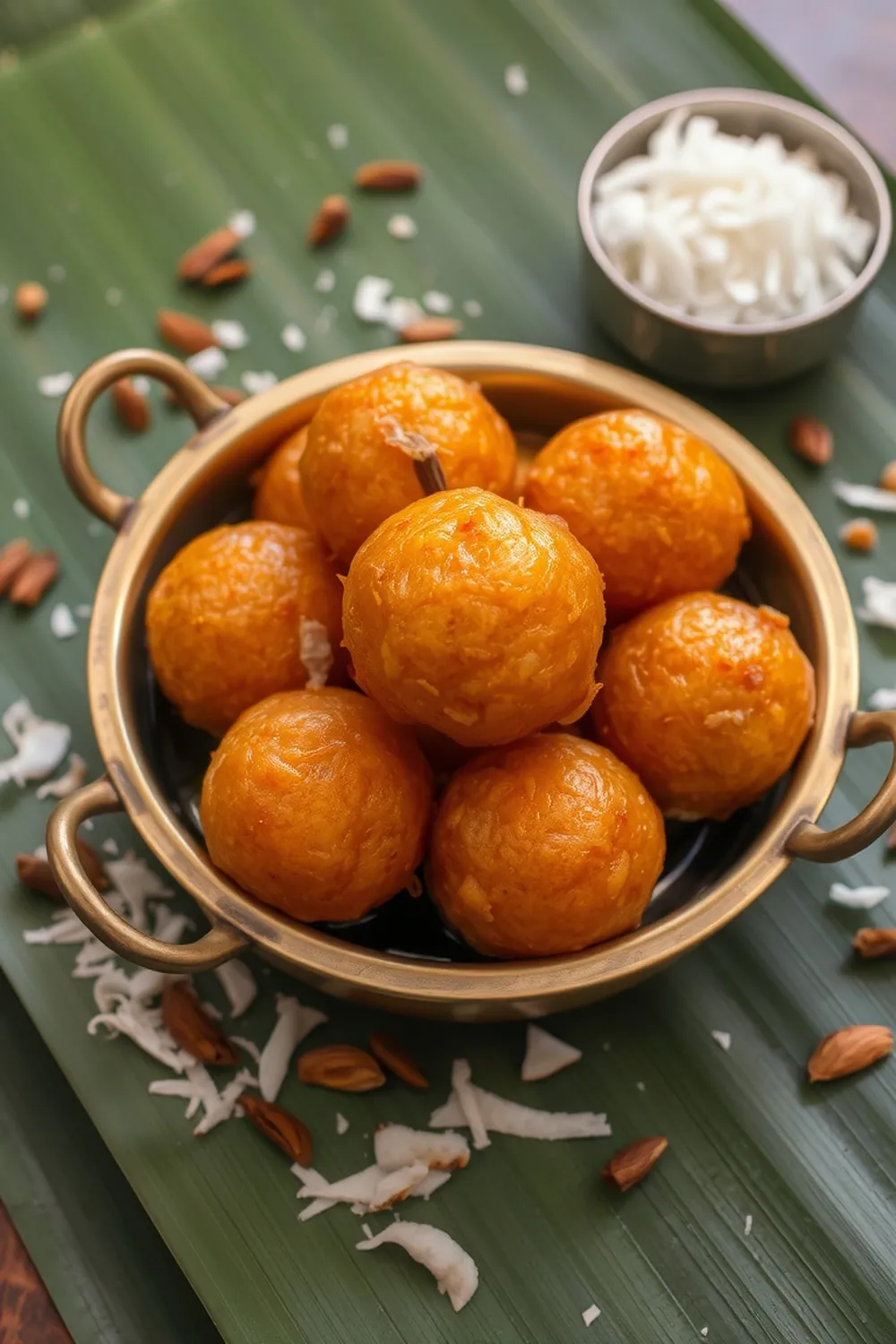- Wash and soak whole wheat overnight. Drain and grind into a coarse paste using minimal water.
- Soak basmati rice for 15-30 minutes.
- Heat ghee in a pressure cooker. Fry cashews and raisins until golden brown, then add the ground wheat paste. Sauté until aromatic.
- Add the drained rice and sauté for 2 minutes.
- Pour in milk and cardamom. Mix well.
- Pressure cook on medium heat until one whistle. Reduce flame and cook for 10 more minutes. Let the pressure release naturally.
- Stir in jaggery until dissolved. Avoid reheating to prevent curdling.
- Serve warm or chilled. Adjust consistency with warm milk if needed.
- Calories:350 kcal25%
- Energy:1464 kJ22%
- Protein:8 g28%
- Carbohydrates:60 mg40%
- Sugar:25 mg8%
- Salt:50 g25%
- Fat:12 g20%
Last Updated on 2 months by Neha Deshmukh
Wheat & Rice Kheer Recipe – Authentic Indian Sweet with Cashews & Jaggery
Introduction
Oh, Kheer! Is there anything more comforting? This Wheat & Rice Kheer (pronounced keer) is a hug in a bowl, honestly. It’s a dessert my grandmother used to make, and the aroma always filled the house with such warmth. It’s a little different from your typical rice kheer, with the addition of wheat, which gives it a lovely, slightly nutty flavour and a beautiful creamy texture. I’m so excited to share this family favourite with you!
Why You’ll Love This Recipe
This isn’t just any kheer. It’s a beautiful blend of textures and flavours – the soft rice, the slightly chewy wheat, the crunch of cashews, and the warm sweetness of jaggery. It’s surprisingly easy to make, especially with the pressure cooker method, and it’s a guaranteed crowd-pleaser. Plus, it’s a wonderful way to enjoy a traditional Indian dessert that’s both satisfying and nourishing.
Ingredients
Here’s what you’ll need to create this deliciousness:
- ¼ cup whole wheat
- 2 tbsp basmati rice
- 1 tbsp ghee
- 5 cashew nuts
- 8-10 raisins
- 3 cups low fat milk (720ml)
- 1 pinch cardamom
- ¼ cup grated jaggery (50g)
Ingredient Notes
Let’s talk ingredients! Getting these right makes all the difference.
Whole Wheat – Regional Variations & Health Benefits
We’re using whole wheat here, which adds a lovely depth of flavour and a bit of a nutritional boost. In some regions of India, broken wheat (dalia) is also used, which cooks a little faster. About 50g of whole wheat is perfect for this recipe.
Basmati Rice – Choosing the Right Grain
Basmati rice is key for that delicate, fragrant flavour. Look for aged basmati – it tends to be less sticky and cooks up fluffier. Around 30-40g of rice is ideal.
Ghee – The Importance of Quality
Ghee (clarified butter) is essential for that authentic flavour. Don’t skimp here! Good quality ghee will make a huge difference. 15ml is all you need.
Jaggery – A Traditional Sweetener & Its Nuances
Jaggery is unrefined cane sugar, and it adds a beautiful caramel-like flavour that’s so much more complex than regular sugar. It also has a lovely warmth to it. 50g of grated jaggery works beautifully. If you can’t find jaggery, you can use sugar (see FAQs).
Cardamom – Fresh vs. Ground & Aroma
Freshly ground cardamom is always best, but good quality ground cardamom works too. A pinch is all you need – it’s potent! It adds such a lovely fragrance.
Step-By-Step Instructions
Alright, let’s get cooking!
- Start by washing the whole wheat and soaking it overnight. This softens it and helps it cook evenly. The next day, drain the wheat and grind it into a coarse paste with minimal water – you want it to be a little grainy, not completely smooth.
- While the wheat is soaking, soak the basmati rice for about 15 minutes. This helps it become nice and plump. Drain it well before using.
- Now, heat the ghee in a pressure cooker over medium heat. Add the cashew nuts and raisins and fry them until they turn golden brown. Be careful not to burn them!
- Add the ground wheat paste to the pressure cooker and sauté for a few minutes until it becomes fragrant. This step is important to get rid of the raw wheat smell.
- Add the drained rice and sauté for another 2 minutes.
- Pour in the milk and add the cardamom. Give everything a good mix.
- Close the pressure cooker lid and cook on medium heat until you hear one whistle. Then, reduce the flame to low and cook for another 10 minutes. Let the pressure release naturally – don’t force it!
- Once the pressure has released, open the lid and stir in the grated jaggery. Stir until it’s completely dissolved. Don’t reheat the kheer after adding the jaggery, as it might curdle.
- If the kheer is too thick, you can adjust the consistency by adding a little warm milk.
Expert Tips
- Don’t overcook the wheat: You want it to be cooked through, but still retain a little texture.
- Stir frequently: Especially towards the end, to prevent sticking.
- Patience is key: Letting the pressure release naturally is crucial for a creamy texture.
Variations
- Vegan Adaptation: Swap the ghee for coconut oil and the milk for plant-based milk (almond or oat milk work well).
- Gluten-Free Considerations: While wheat isn’t gluten-free, you can substitute it with an equal amount of sago (sabudana) for a gluten-free version.
- Spice Level Adjustment (Cardamom): If you love a stronger cardamom flavour, add another pinch!
- Festival Adaptations (Diwali, Holi): For Diwali, you can garnish with silver leaf (vark). For Holi, a sprinkle of saffron adds a beautiful colour and flavour.
Serving Suggestions
This kheer is delicious served warm or chilled. I love to garnish it with a few extra cashew nuts and raisins. It’s perfect as a dessert after a hearty Indian meal, or even as a comforting treat on a chilly evening.
Storage Instructions
Store leftover kheer in an airtight container in the refrigerator for up to 3 days. It might thicken as it cools, so just add a splash of warm milk when reheating.
FAQs
What is the best type of rice to use for Kheer?
Basmati rice is definitely the best! Its long grains and fragrant aroma make it perfect for kheer.
Can I use sugar instead of jaggery? What adjustments should I make?
Yes, you can! Use ¾ cup of sugar for every ¼ cup of jaggery. You might also find the kheer a little less flavourful, so consider adding a tiny pinch of vanilla extract.
How can I prevent the Kheer from sticking to the bottom of the pressure cooker?
Stir frequently, especially during the initial sautéing stages. Using a heavy-bottomed pressure cooker also helps.
Can this Kheer be made on the stovetop instead of in a pressure cooker?
Absolutely! It will take longer, about 45-60 minutes, and you’ll need to stir more frequently to prevent sticking. Cook on low heat, stirring almost constantly.
What is the significance of soaking the wheat and rice?
Soaking softens the grains, making them easier to digest and cook evenly. It also helps create a creamier texture.
How can I adjust the sweetness level of the Kheer?
Start with the recommended amount of jaggery and taste as you go. You can always add more, but you can’t take it away!










